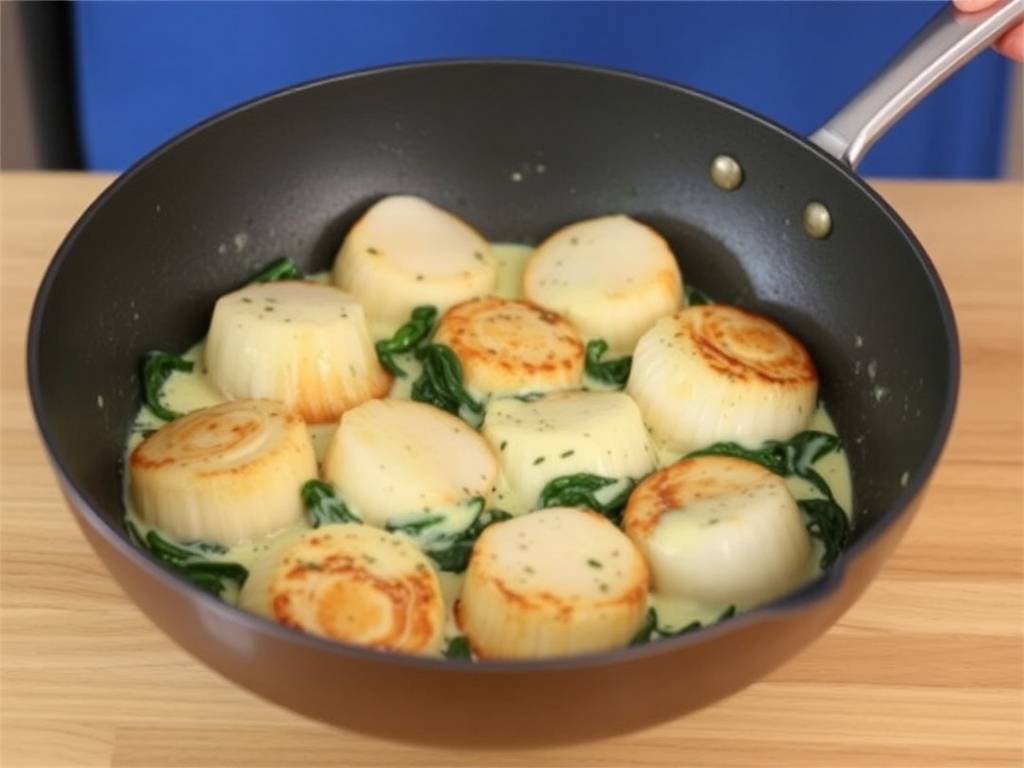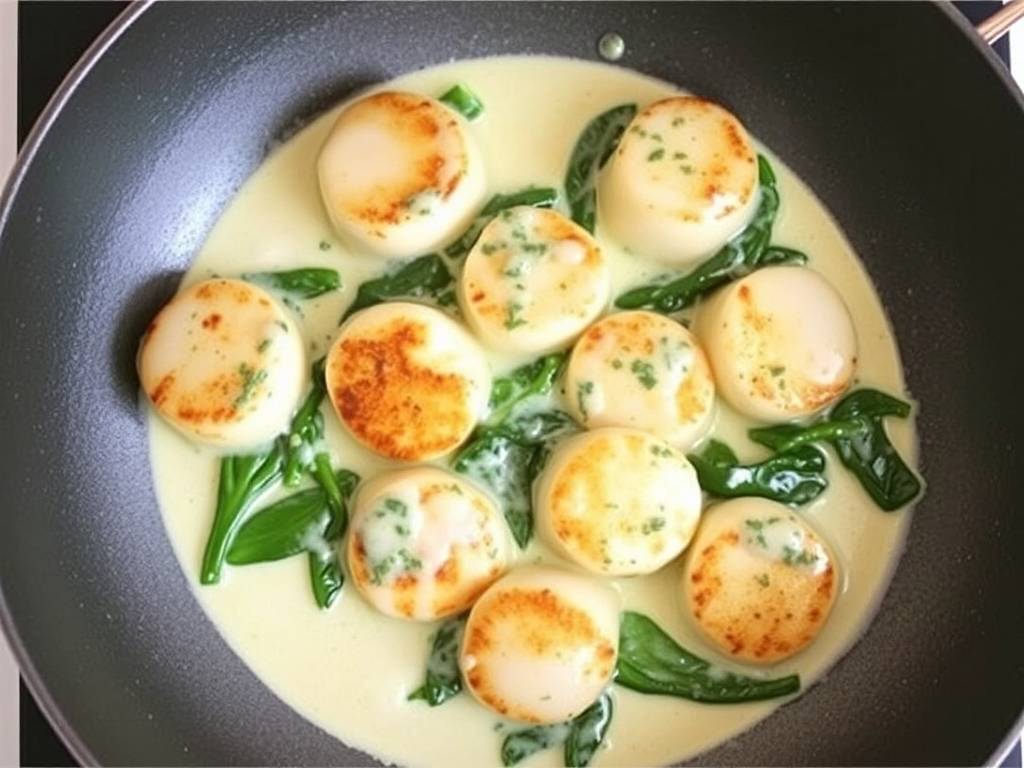Pan-Seared Scallops with Creamed Spinach: A Restaurant-Quality Meal at Home
There's something undeniably luxurious about perfectly cooked scallops. Their delicate sweetness, golden-brown crust, and tender, buttery interior can transform a simple weeknight dinner into a special occasion. Yet, for many home cooks, the thought of preparing scallops can be intimidating. How do you get that beautiful sear without overcooking them? What pairs well with their subtle flavor?
The answer lies in this stunning, yet surprisingly simple, dish: Scallops with Spinach and Cream Sauce. This recipe is the ultimate guide to creating a restaurant-worthy meal in your own kitchen. We'll walk through every step, from selecting the best ingredients to mastering the pan-searing technique and crafting a velvety, flavorful sauce that brings everything together. This comprehensive tutorial will address all your questions, ensuring you feel confident and excited to cook this elegant seafood dish.

Why This Scallop and Creamed Spinach Recipe Works
This combination is a classic for a reason. The rich, savory cream sauce clings to the vibrant, slightly earthy spinach, creating a lush bed for the sweet, caramelized scallops. It’s a harmony of textures and flavors that feels both indulgent and balanced. Whether you're planning a romantic date night, a holiday meal, or simply want to treat yourself, this dish delivers on every front.
The key to success is understanding a few fundamental techniques. Don't worry; they are easier than you think! We'll cover the crucial steps for how to cook scallops perfectly, how to make a cream sauce that doesn't break or become greasy, and how to wilt spinach so it retains its beautiful color and texture. By the end of this guide, you'll have a foolproof method for an impressive seafood dinner.
Selecting Your Ingredients: The Foundation of Flavor
Great dishes start with great ingredients. Taking a little extra care here will make a world of difference in your final plate.
-
The Scallops: For the best searing results, you want "dry-packed" sea scallops. Avoid "wet-packed" scallops, which are treated with a sodium solution that makes them absorb water. This extra moisture prevents them from browning properly and can cause them to steam in the pan. Look for scallops that are firm, smell fresh and sweet (not fishy), and have a creamy white or light pinkish-beige color. For a uniform cook, try to select scallops that are similar in size. The keyword here is "how to choose dry-packed scallops for searing" – it's the single most important tip for a perfect crust.
-
The Spinach: Fresh spinach is ideal. You can use flat-leaf or baby spinach; baby spinach is more tender and has a milder flavor. Remember that spinach wilts dramatically, so what looks like a massive bag will cook down to a much smaller amount. A 5-ounce bag or bunch is usually perfect for two servings.
-
The Cream Sauce Components: You'll need heavy cream (or double cream) for a luxuriously rich and stable sauce, a good dry white wine (like Sauvignon Blanc or Pinot Grigio) for depth and acidity, shallots and garlic for an aromatic base, and a touch of nutmeg, which is a classic and wonderful pairing with both spinach and cream. Freshly grated nutmeg is far superior to pre-ground, but use what you have. Parmesan cheese is optional but adds a lovely salty, umami kick.
Essential Equipment for Cooking Scallops
You don't need a professional kitchen, but a few key tools will help immensely:
- A Heavy-Bottomed Skillet: A cast-iron skillet or a heavy stainless-steel pan is perfect. These materials distribute heat evenly, which is crucial for getting an even, golden sear on your scallops without hot spots. Non-stick pans are okay, but they often don't get hot enough to create a truly robust crust.
- Tongs or a Thin, Flexible Spatula: You'll need something to flip the scallops gently without piercing them.
- A Separate Sauté Pan: For wilting the spinach and making the cream sauce. You can use the same pan after cooking the scallops if you wipe it out, but having two pans streamlines the process.
Step-by-Step Guide: How to Cook Scallops with Spinach and Cream Sauce

Let's break down the process into manageable stages. The entire dish comes together in about 30 minutes, making it an excellent choice for an impressive yet efficient meal.
Part 1: Preparing the Scallops for a Perfect Sear
This is the most critical step. Proper preparation is 90% of the battle.
- Thaw (If Frozen): If your scallops are frozen, thaw them gradually in the refrigerator overnight. Never thaw them at room temperature or in warm water, as this can compromise their texture.
- Pat Them DRY: This is non-negotiable. Use several paper towels to pat each scallop completely dry. Remove as much surface moisture as possible. This is the secret to achieving that beautiful, caramelized crust instead of steaming them. Think of it as the golden rule of "how to get a perfect sear on scallops."
- Season: Just before cooking, season both sides of the scallops generously with kosher salt and freshly ground black pepper.
Part 2: Cooking the Creamed Spinach Base
While your scallops are coming to room temperature, start the spinach and sauce.
- Sauté Aromatics: In your sauté pan, melt a tablespoon of butter or heat a tablespoon of olive oil over medium heat. Add finely chopped shallot and cook until soft and translucent, about 2-3 minutes. Add minced garlic and cook for another 30 seconds until fragrant.
- Deglaze with Wine: Pour in about a quarter cup of white wine. Let it simmer and reduce by about half, scraping any browned bits from the bottom of the pan. This step, known as deglazing, adds incredible flavor to your sauce.
- Wilt the Spinach: Add the fresh spinach in handfuls, stirring constantly. It will seem like a lot, but it will wilt down quickly. This should only take 2-3 minutes.
- Create the Cream Sauce: Reduce the heat to low. Pour in the heavy cream and add a tiny pinch of nutmeg. Let the sauce simmer gently for a few minutes until it thickens slightly. If you're using Parmesan, stir it in now until melted. Season the creamed spinach with salt and pepper to taste. Once done, remove it from the heat and cover to keep warm.
Part 3: The Main Event: Pan-Searing the Scallops
Now for the star of the show. This part is fast, so have your plate ready!
- Get the Pan Hot: Place your heavy-bottomed skillet over medium-high heat. Let it get properly hot. Add a high-smoke-point oil, like avocado oil or grapeseed oil. A thin layer should shimmer and look fluid.
- Place the Scallops: Carefully place the dried and seasoned scallops in the hot pan, making sure they are not touching each other. This ensures they sear instead of steam.
- DO NOT TOUCH THEM: This is the hardest part! Resist the urge to move them. Let them cook undisturbed for 1.5 to 2 minutes. You'll know they are ready to flip when the edges look opaque and a deep golden-brown crust has formed on the bottom.
- Flip and Finish: Gently flip each scallop. They should release easily from the pan if a good crust has formed. Cook for another 60-90 seconds on the second side. The scallops are done when they are firm to the touch but still have a slight springiness—this is the key to "cooking scallops to the perfect tenderness." They should be opaque all the way through. Overcooking will make them tough and rubbery.
Part 4: Plating Your Masterpiece
Spoon a generous bed of the creamy spinach onto warm plates. Artfully arrange the seared scallops on top of the spinach. For a final touch, you can drizzle a little of the remaining cream sauce from the spinach pan over the scallops, garnish with a sprinkle of fresh parsley or chives, and perhaps a squeeze of fresh lemon juice to cut through the richness.
Serving Suggestions and Wine Pairings
This dish is a complete meal on its own, but it pairs wonderfully with:
- Pasta or Polenta: Serve it over a bed of fettuccine or creamy Parmesan polenta to soak up every last drop of the sauce.
- Crusty Bread: A warm, crusty baguette is essential for mopping up the delicious cream sauce.
- A Simple Salad: A light arugula salad with a lemon vinaigrette provides a refreshing contrast.
For wine, a crisp, acidic white wine like Chardonnay (unoaked or lightly oaked), Sauvignon Blanc, or a French Chablis complements the richness of the cream and the sweetness of the scallops perfectly.
Troubleshooting Common Issues
- My scallops are steaming, not searing. This means there was too much moisture. Ensure you pat them extremely dry next time, and make sure your pan is properly hot before adding them.
- My cream sauce is too thin. Let it simmer for a few more minutes to reduce and thicken. You can also add a little more Parmesan cheese.
- My cream sauce broke or looks grainy. This can happen if the heat is too high. Always keep the heat low when working with cream. If it breaks, you can sometimes save it by removing it from the heat and whisking in a tablespoon of cold cream.
- I overcooked my scallops. It happens to the best of us! They will be chewy. Use a timer next time and remember that they continue to cook a little after being removed from the pan.
Cooking scallops at home doesn't have to be daunting. With this detailed guide on "how to cook scallops with spinach and cream sauce," you have all the knowledge you need to create a truly spectacular dish. It’s a recipe that celebrates simple, quality ingredients and empowers you to master a few key techniques. So, go ahead, grab your skillet, and get ready to impress yourself and your loved ones with this elegant and delicious meal. Happy cooking






发表评论